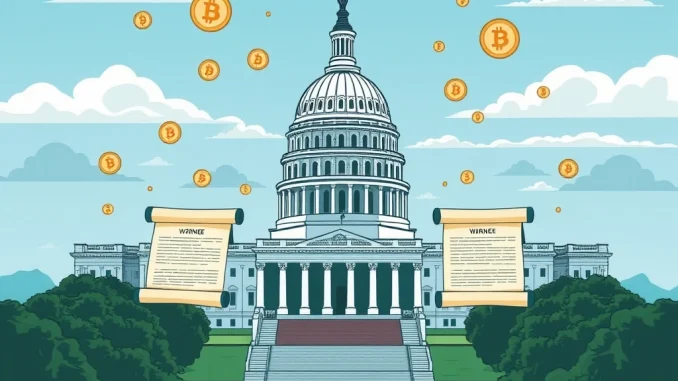
Big news is circulating regarding the path forward for US crypto regulation in the House of Representatives. Reports suggest lawmakers are considering a significant move: potentially advancing two key pieces of legislation – the GENIUS Act focused on stablecoins and the CLARITY Act addressing crypto market structure – together. This strategic bundling appears aimed at meeting a suggested August deadline put forth by former President Donald Trump, who recently urged the House to pass stablecoin legislation quickly. This development, noted by Crypto in America host Eleanor Terrett, signals a potentially accelerated timeline for establishing clearer rules in the US digital asset space.
Understanding the Key Pieces of US Crypto Regulation
Before diving into the implications of combining these efforts, it helps to know what each bill is generally about. The push for US crypto regulation isn’t new, but these specific bills represent distinct yet related aspects of the digital asset market.
- The GENIUS Act: While details can evolve, this legislation typically focuses on stablecoins. These digital currencies are designed to maintain a stable value relative to an asset like the US dollar. Regulation aims to ensure they are backed appropriately, manage risks, and protect consumers from potential failures.
- The CLARITY Act: This bill is broader, tackling the overall crypto market structure. It seeks to provide definitions for digital assets, clarify the roles of regulatory agencies like the SEC and CFTC, and establish rules for exchanges and other market participants. The goal is to bring more certainty and oversight to the broader crypto ecosystem.
Why Combine the Stablecoin Bill and Market Structure Efforts?
Considering the GENIUS stablecoin bill and the CLARITY crypto market structure bill together is an interesting legislative tactic. Here are a few potential reasons:
Passing comprehensive crypto legislation in the US has been a slow process. By combining these two bills, lawmakers might hope to:
- Accelerate Progress: Addressing both stablecoins and market structure in one package could streamline the legislative process, potentially saving time compared to passing them individually.
- Address Interconnected Issues: Stablecoins operate within the broader crypto market structure. Regulating one often impacts the other. A combined approach could allow for more cohesive and less contradictory rules.
- Build Broader Coalitions: Lawmakers with different priorities (some focused on stablecoins, others on market structure) might find common ground in a combined bill, making it easier to gather enough votes for passage.
The Trump Factor and the August Deadline
The mention of President Trump’s suggested August deadline adds a layer of political urgency. Trump has recently expressed more favorable views towards crypto and specifically called for swift passage of stablecoin bills. His involvement signals that crypto regulation is becoming a more prominent political issue, potentially influencing the legislative timeline.
An August deadline, while not a formal legislative requirement, creates pressure. It could motivate House leadership to find a path forward before the traditional August recess or the intensification of election season activities. This political impetus could be a key driver behind considering the combined approach for the GENIUS Act and the CLARITY Act.
Potential Benefits and Challenges of Joint Passage
Advancing the GENIUS Act and CLARITY Act together has potential upsides and significant hurdles.
Potential Benefits:
- Faster Certainty: A combined bill could provide the crypto industry with clearer rules on both stablecoins and broader market operations sooner.
- Holistic Approach: Regulation could be designed to work together, avoiding potential conflicts between stablecoin rules and overall market rules.
- US Competitiveness: Passing comprehensive US crypto regulation could signal that the US is serious about providing a framework for the industry to grow domestically.
Potential Challenges:
- Increased Complexity: Combining two complex bills makes the overall package larger and potentially harder to negotiate and understand.
- Finding Consensus: Disagreements exist on specific provisions within both the stablecoin bill and the crypto market structure bill. Combining them means all disagreements must be resolved in a single negotiation.
- Risk of Failure: If consensus cannot be reached on one part of the combined bill, it could potentially sink the entire package, leaving both stablecoin and market structure regulation unresolved.
- Industry Pushback: Specific provisions in either bill might face opposition from different parts of the crypto industry, complicating passage.
What Comes Next for US Crypto Regulation?
The report suggests the House is *considering* this path, not that it’s finalized. The actual legislative process involves committee approvals, floor debates, and eventual negotiation with the Senate (which has its own approaches to crypto regulation). Even if the House passes a combined bill, reconciling it with potential Senate versions will be a major task.
Stakeholders in the crypto space should watch closely:
- Committee Actions: Keep an eye on committees like the House Financial Services Committee, which have been active on these bills.
- Bipartisan Negotiations: The success of a combined bill likely hinges on achieving significant bipartisan agreement.
- Senate Developments: Any progress in the House will eventually need to align with the Senate’s efforts.
A Crucial Moment for US Crypto Policy
The potential move by the US House to consider joint passage of the GENIUS Act and CLARITY Act represents a significant moment for US crypto regulation. Driven by political pressure and the desire for clearer rules, this approach could potentially accelerate the establishment of frameworks for stablecoins and the broader crypto market structure. However, combining complex legislation also introduces substantial challenges in finding consensus and navigating the political landscape. The coming weeks leading up to the suggested August deadline will be critical in determining if this legislative strategy can successfully move forward, shaping the future of the crypto industry in the United States.



